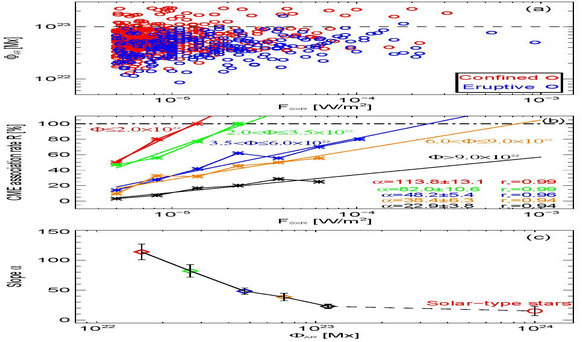Exploring Eruptions from the Sun
In our solar system, solar flares and coronal mass ejections (CME) are the most spectacular eruptive activities. Large solar flares and CMEs could bring us disastrous spaceweather, destroy our satellite and navigation system, and cause a large-scale blackout on the Earth.
Solar activity sometimes stays trapped close to the Sun’s surface - but sometimes it breaks free in enormous ejections of hot plasma. What determines whether a solar flare stays confined or is followed by a catastrophic eruption? A new study reveals clues and has been published on The Astrophysical Journal Letters this August.
A new study led by Dr. Ting Li from National Astronomical Observatories of Chinese Academy of Sciences (NAOC) further explores how the fate of a flare may be influenced by the active region (AR) where it originates. They used the 10 years observations from the satellite of Solar Dynamics Observatory (SDO) during 2010-2019 and established the largest flare database to date. The database includes 719 solar flares and involves the eruptive character of each large flare.
They found that the larger the total magnetic flux of the flare-host active region, the less likely the flare is associated with a CME. For a given flare intensity, the flare is more likely to come with an eruptive CME if its active region has less magnetic flux. More magnetic flux means that there’s stronger confinement of the flare by an overlying background field, preventing it from erupting.
Based on these solar observations, they also speculated on the association rate R for solar-type stars by taking a representative stellar AR magnetic flux of 1024 Mx. For X100-class "superflares" on solar-type stars, no more than 50% flares can generate stellar CMEs. This may help to provide an explanation why the detection of stellar CMEs is rare.
The results have important implications for the prediction of CMEs occurring in association with large flares as well as for the solar-stellar connection, where the solar flare-CME association rates are used to estimate stellar CME occurrence frequencies.
This work was a collaboration with China Meteorological Administration, the School of Physics and Materials Science at the Anhui University, and the Institute of Physics & Kanzelhohe Observatory for Solar and Environmental Research at University of Graz in Austria.

Figure: Relations of flare–CME association rate (R) with flare peak softX-ray flux (FSXR) and total unsigned magnetic flux of ARs (ФAR).
(Credit: Ting Li)
This paper can be accessed at https://iopscience.iop.org/article/10.3847/2041-8213/ac1a15?